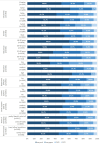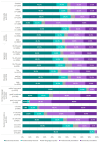Recruiting people with selected citizenships for the health interview survey GEDA Fokus throughout Germany: evaluation of recruitment efforts and recommendations for future research
- PMID: 39266952
- PMCID: PMC11391769
- DOI: 10.1186/s12874-024-02328-w
Recruiting people with selected citizenships for the health interview survey GEDA Fokus throughout Germany: evaluation of recruitment efforts and recommendations for future research
Abstract
Background: Germany is the second most common country of immigration after the US. However, people with own or familial history of migration are not represented proportionately to the population within public health monitoring and reporting. To bridge this data gap and enable differentiated analyses on migration and health, we conducted the health interview survey GEDA Fokus among adults with Croatian, Italian, Polish, Syrian, or Turkish citizenship living throughout Germany. The aim of this paper is to evaluate the effects of recruitment efforts regarding participation and sample composition.
Methods: Data collection for this cross-sectional and multilingual survey took place between 11/2021 and 5/2022 utilizing a sequential mixed-mode design, including self-administered web- and paper-based questionnaires as well as face-to-face and telephone interviews. The gross sample (n = 33436; age range 18-79 years) was randomly drawn from the residents' registers in 120 primary sampling units based on citizenship. Outcome rates according to the American Association for Public Opinion Research, the sample composition throughout the multistage recruitment process, utilization of survey modes, and questionnaire languages are presented.
Results: Overall, 6038 persons participated, which corresponded to a response rate of 18.4% (range: 13.8% for Turkish citizenship to 23.9% for Syrian citizenship). Home visits accounted for the largest single increase in response. During recruitment, more female, older, as well as participants with lower levels of education and income took part in the survey. People with physical health problems and less favourable health behaviour more often took part in the survey at a later stage, while participants with symptoms of depression or anxiety more often participated early. Utilization of survey modes and questionnaire languages differed by sociodemographic and migration-related characteristics, e.g. participants aged 50 years and above more often used paper- than web-based questionnaires and those with a shorter duration of residence more often used a translated questionnaire.
Conclusion: Multiple contact attempts, including home visits and different survey languages, as well as offering different modes of survey administration, increased response rates and most likely reduced non-response bias. In order to adequately represent and include the diversifying population in public health monitoring, national public health institutes should tailor survey designs to meet the needs of different population groups considered hard to survey to enable their survey participation.
Keywords: Hard to survey; Migration; Mixed-mode; Multilingual; Population-based; Random sample; Sequential design; Survey research methods.
© 2024. The Author(s).
Conflict of interest statement
The authors declare no competing interests.
Figures
Similar articles
-
German Health Update Fokus (GEDA Fokus) among Residents with Croatian, Italian, Polish, Syrian, or Turkish Citizenship in Germany: Protocol for a Multilingual Mixed-Mode Interview Survey.JMIR Res Protoc. 2023 Apr 12;12:e43503. doi: 10.2196/43503. JMIR Res Protoc. 2023. PMID: 36790192 Free PMC article.
-
Health of people with selected citizenships: results of the study GEDA Fokus.J Health Monit. 2023 Mar 21;8(1):7-33. doi: 10.25646/11143. eCollection 2023 Mar. J Health Monit. 2023. PMID: 37064418 Free PMC article.
-
COVID-19 vaccination status among people with selected citizenships: results of the study GEDA Fokus.J Health Monit. 2023 Mar 21;8(1):34-51. doi: 10.25646/11142. eCollection 2023 Mar. J Health Monit. 2023. PMID: 37064416 Free PMC article.
-
Results and Strategies for a Diversity-Oriented Public Health Monitoring in Germany.Int J Environ Res Public Health. 2022 Jan 12;19(2):798. doi: 10.3390/ijerph19020798. Int J Environ Res Public Health. 2022. PMID: 35055619 Free PMC article.
-
Impact of summer programmes on the outcomes of disadvantaged or 'at risk' young people: A systematic review.Campbell Syst Rev. 2024 Jun 13;20(2):e1406. doi: 10.1002/cl2.1406. eCollection 2024 Jun. Campbell Syst Rev. 2024. PMID: 38873396 Free PMC article. Review.
References
-
- McAuliffe M, Triandafyllidou A. World Migration Report 2022. International Organization for Migration (IOM). Geneva, Switzerland; 2017.
-
- McAuliffe M, Ruhs M. World Migration Report 2018. International Organization for Migration (IOM). Geneva, Switzerland; 2017.
-
- Statistisches Bundesamt (Destatis). Bevölkerung und Erwerbstätigkeit. Bevölkerung mit Migrationshintergrund. Ergebnisse des Mikrozensus 2022. (Erstergebnisse). In: Fachserie 1 Reihe 2.2. Statistisches Bundesamt (Destatis): Wiesbaden, Germany; 2023.
-
- Statistisches Bundesamt (Destatis). Statistischer Bericht - Mikrozensus - Bevölkerung nach Einwanderungsgeschichte – Erstergebnisse 2022. Statistisches Bundesamt (Destatis): Wiesbaden, Germany; 2023.
-
- Kraler A, Reichel D. Statistics on migration, integration and discrimination in Europe. PROMISTAT Final Report. International Centre for Migration Policy Development: Vienna, Austria; 2010.
MeSH terms
LinkOut - more resources
Full Text Sources
Miscellaneous



